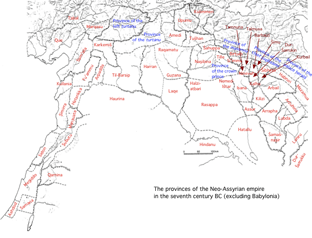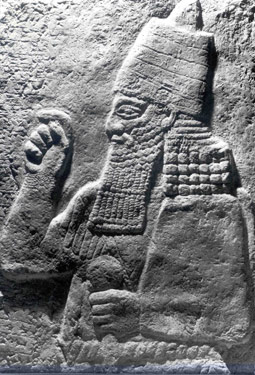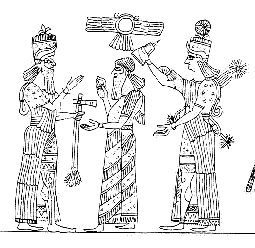The Assyrian empire in the 7th century BC
In the 7th century BC, the kingdom of Assyria was by far the largest Near Eastern empire of its time, encompassing the area of the modern states of Iraq, Syria and Lebanon in their entirety, half of Israel, wide parts of south-eastern Turkey and extensive regions of Western Iran.
A decentralised administration

Map of the Assyrian Empire in the 7th century BC. View large image.
The most important metropolis and the king's main residence was Nineveh PGP , then the largest city on earth. Yet the ancient cult city of Assur PGP always remained the true nucleus of the state, no matter where the administrative capital was situated. Nineveh was merely the successor of Kalhu PGP and Dur-Šarruken PGP , which had filled that role from the 9th to the late 8th century and for about a decade at the end of the 8th century respectively. The venerable city of Assur, however, harboured the one and only temple of the god Aššur PGP , the focal point for the country and, to the Assyrian mind, the entire world. All who were subjects of the Assyrian king and, therefore, servants of Aššur had to provide the temple with sacrifices. This was not only expected of the Assyrian provinces but also all vassal states, who in addition furnished the king with tribute. Assyria's power in the 7th century reached far beyond its borders, to Judah, Philistia PGP , Egypt PGP and Kush (Nubia) PGP , to the island of Cyprus PGP and along the Mediterranean coastline as far as Lydia, penetrating deep into central Anatolia, the Iranian plateau and even the Arabian desert.
Assyria itself was at that time divided into about seventy provinces, each under the control of a governor. The king personally appointed each and every governor, and these in turn answered directly and only to the king. As a rule, governorship was not hereditary: the office could not be passed on from father to son. In order to prevent dynastic ideas and schemes from the outset, the king preferred his governors to be eunuchs - castrated men who were physically unable to have children. The king was understood to be chosen by the gods and to rule by their grace; his word was law, and he could directly intervene at all levels of his empire. Nevertheless, the Assyrian administration was largely decentralised and in their provinces the governors were authorised to act independently on behalf of the king. As far as routine matters were concerned, they operated at their own discretion.
An omnipresent and all-powerful king

Sennacherib, king of Assyria; detail of a rock relief in the Judi Dag mountains, from a cast taken by Otmar Reiter and Hans Thoma, Landshut. Photo by Eberhard Rossner.
But to ensure that all subjects of Assyria were at all times aware that the one person who was all-powerful in the empire was the king, and only the king, his omnipresence and ubiquity was established and guaranteed on various levels. The king maintained residences all over the empire which he visited regularly during his continual travels through his kingdom. In each of these palaces lived an entire royal household, complete with an administrative staff, various supply and maintenance units and also entertainment personnel such as musicians and singers. The average inhabitant of the many Assyrian residence cities will not always have known whether the king was present in his local palace or not; but the imposing building itself was always there, visible every day as a monument to the king's claim to power. Moreover, the king was present in the form of his images. In all major sanctuaries of Assyria, his statues and stelae TT took their place next to the divine image; they were also erected at other prominent locations, such as city gates. And maybe most importantly, each and every inhabitant of Assyria was personally tied to the king by the means of a loyalty oath. Such oaths were imposed at the time of the new king's accession to the throne, but were repeated in the context of important state events such as the election of a crown prince TT . The oath itself was perceived as a spiritual essence, and the oath-taking ceremony included the ritual drinking of water which was thought to cause the oath to enter the body and thus to prevent "from within" any breach of the agreement.
The combination of a decentralised administration and the close personal link between the people and their king was the backbone of the Assyrian empire which had been a constant in the ever-changing political geography of the Middle East, since the 14th century BC. Indeed, the same clan had ruled the ancient city of Assur many centuries prior to its mutation into the centre of a territorial empire, and therefore the dynasty of the Assyrian kings is to be counted among the longest-living in world history (see Royal family).
Royal succession

The Assyrian king receives the insignia of power from the gods Aššur and Ištar; detail from the incised decoration of an Assyrian helmet in the Axel Guttmann collection (AG 504); drawing from H. Born and U. Seidl, Schutzwaffen aus Assyrien und Urartu (Mainz, 1995), 25 fig. 22.
One reason that kingship could so firmly remain in one family's control for more than a millennium was that it did not necessarily pass from father to son or even eldest son. Each of the king's male relatives was a possible successor to the throne, ensuring that the royal bloodline was well protected against its extinction. In principle, all the king's sons, brothers, cousins and nephews, but also more distant relatives, could ascend to the Assyrian throne. However, one requirement was an absolute essential: in order to be king, a candidate needed to enjoy perfect physical and mental health. But even under the proviso of this sensible condition, dozens of possible successors to the throne were usually available. It was the king's exclusive privilege to chose an heir, during his reign and with divine assistance. This heir could use his time as crown prince to gain experience as a ruler in the making and to secure his power base. Usually, he could then hope to ascend to the throne after his predecessor's natural death with wide acceptance.
The struggle for the throne
Nevertheless, time and again Assyria saw controversies and also battles for the throne; but the protagonists were all members of the royal clan. In several instances the struggle for power did not originate in the old king's death, but had already started when his crown prince was chosen. More than once, disappointed hopefuls reacted to the installation of a rival as heir to the throne by killing the ruler, trying to wrest power not only from the old king, but also and especially from his chosen successor. Famously, Sennacherib (704-681) was murdered by two of his sons after selecting a new crown prince, and his chosen heir Esarhaddon (681-669) emerged as king only after a bloody war. While the transmission of power from Esarhaddon to his heir Assurbanipal (668-c.630) was achieved without bloodshed, the war between Assurbanipal and his brother Šamaš-šumu-ukin PGP for control of Babylonia from 652 onwards marked the beginning of decades of internal struggle for control. When the Assyrian Empire collapsed at the end of the 7th century BC, the armies of the Medes and Babylonians may have conquered Assyria's cities and defeated its army but the empire had already been torn apart for centuries by war raging inside its boundaries, fuelled by rival court factions. The city of Assur's unprecedented capture by enemy troops in 614 BC was possible only because the ongoing process of disintegration from within had left Assyria's beacon unprotected and vulnerable. With the sacking and destruction of Assur's shrine and the violation of its master, the god Aššur, Assyria's heart stopped beating. The state organism that it had supported collapsed within a few short years as the Assyrian empire was carved up between Babylonians, Medes and Egyptians.
Further reading
- Curtis and Reade, Art and empire, 1995
- Parpola and Porter (eds.), Helsinki atlas of the Near East, 2001.
- Postgate, 'The Land of Assur', 1992
Content last modified: 17 Dec 2021.
Karen Radner
Karen Radner, 'The Assyrian empire in the 7th century BC', Knowledge and Power, Higher Education Academy, 2021 [http://oracc.museum.upenn.edu/saao/knpp/essentials/assyrianempire/]